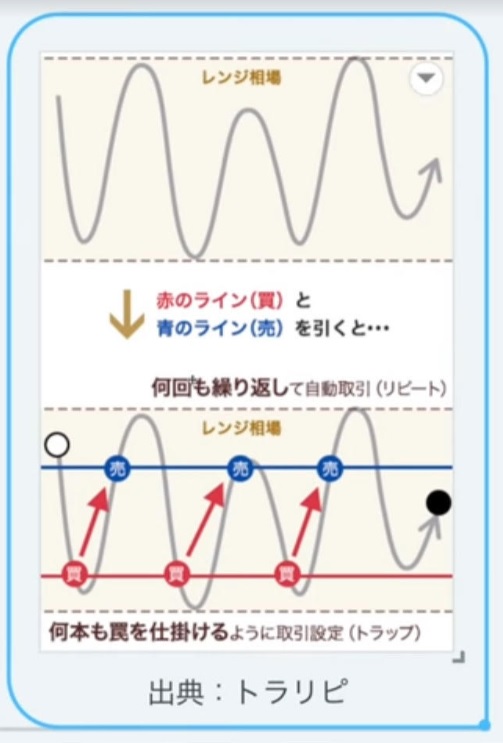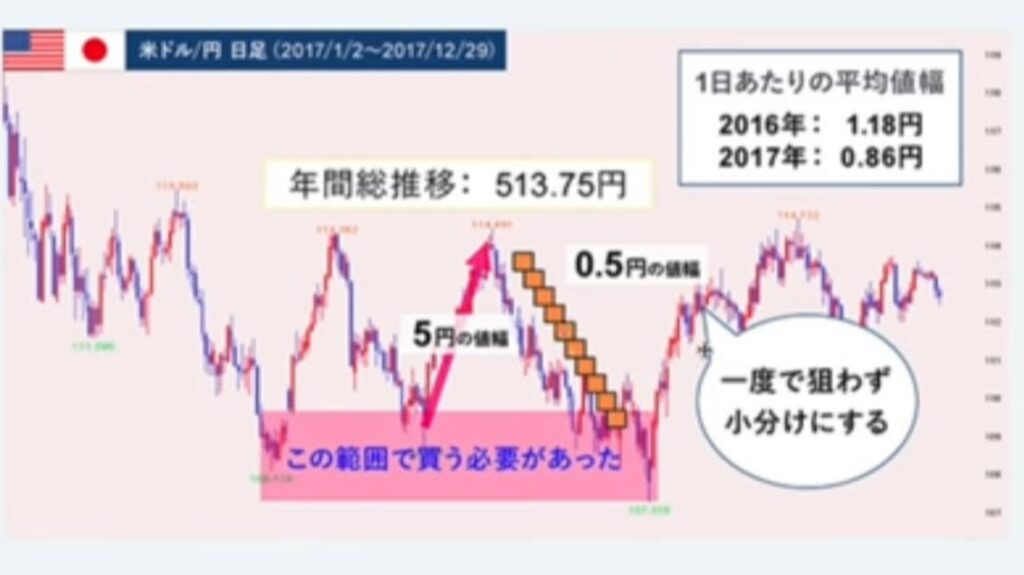管理人オススメコンテンツはこちら
「勝率という概念を全面に押し出す|勝ち続ける秘訣を暴露!FXの常識を覆すトリック」
〜前回のつづき〜
●勝ち続けるのが無理?~じゃあ、95%勝てばいい~

FXの厳しい現実を
ひっくり返すトリックとしては
(1)為替トレードは重労働
ということを
どうやってひっくり返すかというと
取引を自動化してしまえば
重労働にならない訳ですよね?

みたいな。
だから
自動売買ツールを使おうと
薦める訳なんですね。
(2)為替の世界では8〜9割の人が負ける
(3)継続的に勝ち続けられる人はいない
これをどうしたら
ひっくり返す事が出来るかというと
『勝率』という概念を
全面に押し出す事なんですね。
例えば
100回のトレードをして
95回利益確定
5回損失確定
であれば勝率は95%ですよね?

という話なんですが
実現可能なんですよ。
どうすればいいかと言うと
利益確定の幅を小さくして
損失確定の幅を大きくする。
そのように設定すれば
実現可能です。
どういう事かというと
例えば
仮に1ドル100円で
買ったとするじゃないですか。
それを
1ドル100.1円になったら売る。
(この数字は例えばですよ。)
100.1円になったら売る。
0.1円の勝ちですよね?
そして
1ドル90円になっても売る。
こっちは損失の方。
負けの方ですけど
1ドル90円になっても売る。
そうすると
10円の負けですよね?
どっちの方が可能性が高いのか?
という事です。
たった0.1円上がるだけで売るでも
勝ちは勝ちだし
10円=10%値下がりしても
1回の負けには
変わりがない訳です。
確率の話ですよね?
有名なのが『トラリピ』ですね。
というんですけど

何本も罠を仕掛けるような
何遍も同じ仕掛けを
掛けていくんですよね。
そういう様な事を
やっていくんですけど
実際はもう少し複雑な注文で
100円が99.9になったら
更に買うとか
更に99.8円になったら
買うみたいな
『ナンピン買い』
(株価が下落した際に平均取得価格を下げることを目的として追加でその株を購入する投資戦略)
でドンドン買い増していって
一回でも買値以上に
ドル円に限らず為替も株も
行ったり来たり

『レンジ相場』と言いますが
行ったり来たりする時があるので
そういう時を狙ってやるんですけど
ドンドン買い増していって
買い下がっていって
最終的には
1回でも上がってくれたら
確定して売っていく。
そういうやり方をしてる人が
多いんですね。
これは確率の問題ですね。
100回中95回勝つ方法としては
勝率さえ良かったらいい訳ですから
そういうやり方をする訳です。
〜〜〜つづく〜〜〜
Special Thanks college president Ryo.

●おまけ
≪≪Chat-GPTくんによる要約→perplexityちゃんによる文章まとめ≫≫
FX取引は「多くの人が負ける」「継続的に勝つのは難しい」といった厳しい現実がありますが、これを覆す方法として自動売買ツールの活用が挙げられます。
自動売買を使えば、取引の重労働や精神的負担から解放され、初心者でも安定したトレードが可能です。
また、「勝率95%」という高い勝率を実現するためには、利益確定の幅を小さく、損失確定の幅を大きく設定する手法が用いられます。
たとえば、少しの値上がりで利益を確定し、大きく下がった場合のみ損切りすることで、多くの取引で勝ちを積み重ねることができます。
代表的な手法としては「トラリピ」や「ナンピン買い」などがあり、レンジ相場での高い勝率を狙う戦略として多く利用されています。
ただし、1回の損失が大きくなるリスクもあるため注意が必要です。
Citations:
[1] https://min-fx.jp/start/autobuysell/
[2] https://kabutan.jp/hikaku/fx_what-is-fx-automatic-trading/
[3] https://www.gaitame.com/beginner/start/automated.html
[4] https://www.rakuten-card.co.jp/minna-money/securities/investment_other/article_2204_00006/
[5] https://www.dukascopy.jp/useful-information/wiki/fx-automated-trading-ea/
[6] http://shihoushoshi.main.jp/blog/archives/cat_0a_p.html
[7] https://www.invast.jp/blogs/advantages-of-automated-trading-forex/
[8] https://www.matsui.co.jp/fx/study/article/glossary/auto-trading/
≪≪Chat-GPTくんによる英訳≫≫
~Continuing from Last Time~
【Can’t win consistently? Then just win 95% of the time.】
To overturn the harsh realities of FX trading,
you need a trick—a shift in perspective.
—
(1) “FX trading is hard labor.”
How do we flip that idea?
If you automate the trading,
it no longer becomes labor-intensive, right?
> 💬 “It becomes passive income!”
Exactly.
That’s why we recommend using automated trading tools.
—
(2) “8 to 9 out of 10 people lose money in FX.”
(3) “Nobody can keep winning consistently.”
So, how do we flip that narrative?
We put “win rate” front and center.
Let’s say you make 100 trades:
95 of them close in profit
5 of them end in loss
That’s a 95% win rate, right?
> 💬 “Wait, is that even possible?”
Actually—yes, it is.
—
How?
By making your take-profit range small
and your stop-loss range large.
—
For example:
You buy 1 USD at 100 yen.
You sell at 100.1 yen.
That’s a 0.1 yen profit.
And if it drops to 90 yen?
You set that as your stop-loss.
That’s a 10 yen loss.
Which is more likely to happen?
A 0.1 yen gain
Or a 10 yen drop?
A win is a win—even if it’s small.
A 10% drop? Still just one loss.
This is all about probability.
—
The well-known method: “Trap-Repeat-If-Done” (aka ‘Tralipi’)
It’s like setting multiple traps.
You repeat the same setup over and over again.
In reality, the order logic gets a bit more complex.
Like:
Buy at 100 yen
If it drops to 99.9, buy again
If it drops to 99.8, buy even more
This is a strategy called “averaging down”,
where you lower the average purchase price by buying more as it drops.
Eventually, even if the price goes up just once,
you close in profit.
This works especially well in a range-bound market,
where prices move back and forth.
So you keep buying as it drops, and once it goes up a little, you sell.
A lot of people follow this strategy.
—
Final Point
It’s all about probability.
As long as your win rate is high,
winning 95 out of 100 trades is absolutely possible.
That’s the method.
Special Thanks OpenAI and Perplexity AI, Inc








